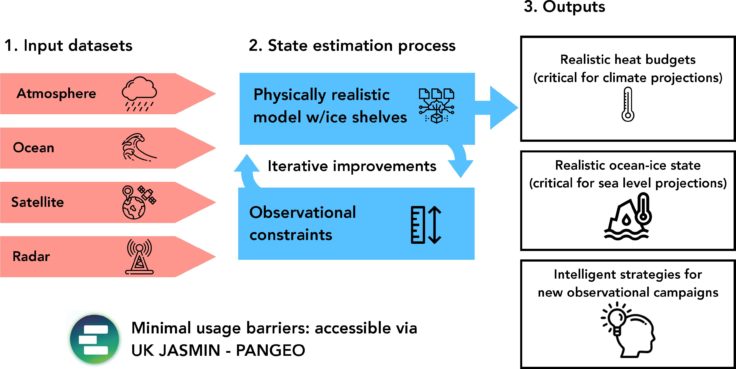SO-WISE
The Southern Ocean - Weddell Sea - Ice Shelf State Estimate (SO-WISE)
- Start date
- 2 November, 2020
- End date
- 31 October, 2024
We are constructing observationally-constrained estimates of the state of the Weddell Gyre, including associated ice shelves and sea ice
Introduction
In the 25 years between 1992 and 2017, ocean melting has caused ice thinning to spread across West Antarctica so rapidly that a quarter of its glacial ice is now affected. This has serious consequences for global and regional sea level rise; the largest source of uncertainty in sea level rise projections is associated with the contribution of the West Antarctic Ice Sheet (WAIS). Although our understanding of these critical ocean-ice systems is rapidly developing, there is a significant gap in our knowledge of how heat is delivered from the open oceans to the under-ice cavities, where the heat can melt the vulnerable undersides of the floating ice shelves, thereby potentially contributing to ice sheet instability and sea level rise.
Objectives
Despite its importance, the Southern Ocean is the world’s biggest data desert, especially in winter. Observations at the interface between the ocean and ice shelves are logistically difficult and costly to obtain, and our understanding of the typically unresolved processes under the ice shelves is still in its infancy. In order to address this gap, we will produce a hierarchy of observationally-constrained state estimates that will help us:
- extract additional value from existing and planned observations,
- deepen our understanding of the coupled ocean-ice systems that regulate sea level rise, and
- make data-driven choices for future observational campaigns.
In order to construct the state estimates, we will use data from the NERC ORCHESTRA and EU SO-CHIC projects, among others, to constrain a numerical model of the Weddell Gyre region, including relevant ice shelves and sea ice. We will use the core process developed by the ECCO consortium for oceanographic state estimation. Ultimately, we will share the results of this process in an open fashion using an instance of Pangeo.

![]()
This work is funded under the UKRI Future Leaders Fellowship scheme.
The strategic aim for this work is to create a next-generation ocean-ice modelling framework that will lead to more robust projections of future sea level rise. In order to achieve this aim, we will focus on three objectives:
- Establish an ocean-ice state estimation framework, producing observationally-constrained ocean-ice simulations using sensitivity analysis (i.e. adjoint modelling) techniques
- Quantify melt rate patterns, heat budgets, and sensitivities of ice shelf melt rate to local and remote atmospheric and oceanic conditions using the ocean-ice state estimates
- Inform the design of future observational campaigns using the ocean-ice state estimates
As a result of this project, the international oceanographic and cryospheric community will be better able to understand and predict the future behaviour of the coupled ocean-ice systems that drive sea level rise.
Project partners:
- Matt Mazloff, Scripps Institution of Oceanography, USA
- Martin Losch, Alfred Wegener Institute, Germany
- Dan Goldberg, University of Edinburgh, UK
- J.B. Sallée, L’OCEAN, Paris, France
- Gael Forget, MIT, USA
- Alberto Naveira-Garabato, University of Southampton, UK